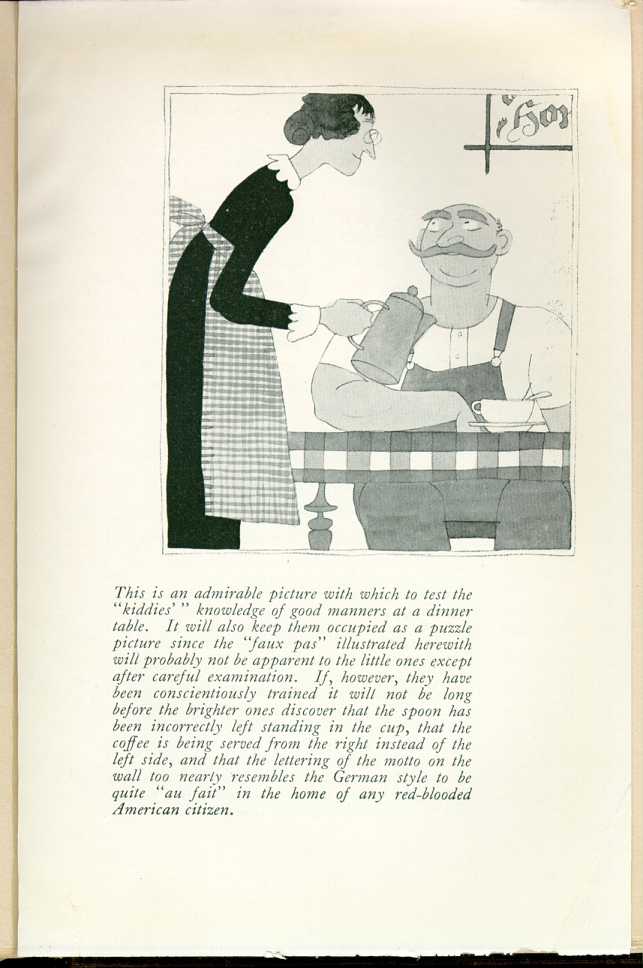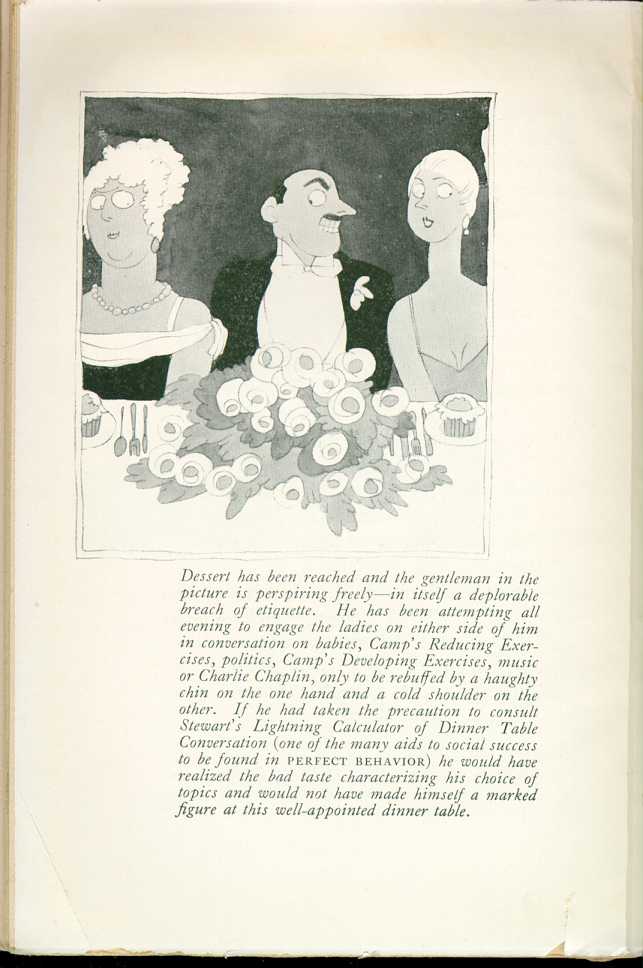|
CHAPTER NINE: THE ETIQUETTE OF DINNERS AND BALLS
Perfect Behavior | ||
TABLE MANNERS FOR CHILDREN
AS a matter of fact, it is never too early to begin to acquire the technique of correct eating, and the nursery is the best possible place for the first lessons in dining-room behavior. Children should be taught at an early age the fundamentals of "table" manners in such a way that by the time they have reached the years of manhood the correct use of knife, fork, spoon and fingerbowl is to them almost

This is an admirable picture with which to test the "kiddies'" knowledge of good manners at a dinner table. It will also keep them occupied as a puzzle picture since the "faux pas" illustrated herewith will probably not be apparent to the little ones except after careful examination. If, however, they have been conscientiously trained it will not be long, before the brighter ones discover that the spoon has been incorrectly left standing in the cup, that the coffee is being served from the right instead of the left side, and that the lettering of the motto on the wall too nearly resembles the German style to be quite "au fait" in the home of any red-blooded American citizen.
[Description: Drawing of a woman standing over a seated man with a coffee pot in her hand. ]
Dessert has been reached and the gentleman in the picture is perspiring freely—in itself a deplorable breach of etiquette. He has been attempting all evening to engage the ladies on either side of him in conversation on babies, Camp's Reducing Exercises, politics, Camp's Developing Exercises, music or Charlie Chaplin, only to be rebuffed by a haughty chin on the one hand and a cold shoulder on the other. If he had taken the precaution to consult Stewart's Lightning Calculator of Dinner Table Conversation (one of the many aids to social success to be found in PERFECT BEHAVIOR) he would have realized the bad taste characterizing his choice of topics and would not have made himself a marked figure at this well-appointed dinner table.
[Description: Drawing of a man with clenched teeth seated in between two women at a dinner table. ]Thus, for example, if you are a father and your boy Edward persists in bringing his pet tadpole to the table in a glass jar, you should not punish or scold him; a much more effective and graphic method of correcting this habit would be for you to suddenly pick up the tadpole one day at luncheon and swallow it. No whipping or scolding would so impress upon the growing boy the importance of the fact that the dinner table is not the place for pets.
Another effective way of teaching table manners to children consists in making up attractive games about the various lessons to be learned. Thus, whenever you have guests for dinner, the children can play "Boner" which
- If the guest has dirty hands, 5 points.
- If the guest uses wrong fork or spoon, 5 points.
- If the guest chokes on bone, 8 points.
- If the guest blows on soup, 5 points.
- If the guest drops fork or spoon, 3 points.
- If the guest spills soup on table, 10 points.
- If the guest spills soup on self, 1 point.
Of course it is often well to tell the guests about the game in advance in order that they may not feel embarrassed but will enter thoroughly into the spirit of this helpful sport.
|
CHAPTER NINE: THE ETIQUETTE OF DINNERS AND BALLS
Perfect Behavior | ||